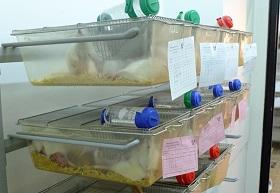The Missing Kingdom: Why Fungi Must Be Central to Conservation Strategy
28 December 2025
Published online 13 November 2013

An Egyptian team has delivered promising results in their attempt to find a stem-cell-based treatment for diabetes.
The team, from the Urology and Nephrology Center (UNC) in Mansoura, is among several in the country working extensively with stem cell technology, despite a lack of resources and limited manpower. Scientists, led by urologist Mohamed Ghoneim, have cured a diabetic rodent and are hoping they can replicate results using human cells.
Ghoneim, who helped establish the UNC three decades ago, says current medication and dietary advice is not enough: "You can try and cure type 2 diabetes by administering a better diet, or by medicating the patient, but eventually the insulin producing cells in the pancreas will stop secreting sufficient quantities of insulin and the patient will become insulin dependent."
His team focused on transforming mesenchymal stem cells (MS cells) – adult bone marrow stem cells – into insulin-producing cells. They selected this type due to its multipotentency, which allows it to differentiate into different cell types such as blood, liver, lung, skin, muscle, neuron and insulin-producing cells.
Adult bone-marrow-derived stem cells can also be expended ex vivo for a long period without differentiating and they provide a rich source of autologous stem cells that are derived from a patient's own body, eliminating the risk of rejection.
The recent successful study began with a series of experiments in which MS cells were made into insulin-producing cells, cultured in a glucose-rich medium containing activation and growth agents and transformed into insulin-producing islet-like structures. The percentage of cells that became effective insulin-producing cells was a modest 1.5 to 5%.
But when these cell clusters were transplanted under the kidney of a diabetic nude mouse — a lab mouse with an inhibited immune system — its sugar levels became normal in about four weeks.
"We were amazed. It seemed impossible that such a low percentage of insulin-producing cells could cure a diabetic mouse," says Ghoneim.
After months of trying to understand why so few cells had such an impact, last week the scientists got their answer: further cell differentiation took place in vivo after the injection of the insulin-producing cells.
"We calculate that at week four the initial low percentage of insulin-producing cells had risen to 20 or 30%, which was enough to cure the mouse and return its normal glycemic status," explains Ghoneim.
His team is yet to find out how many clusters would be needed to treat a human, if indeed the process would be possible to replicate.
In the initial trial phases, the scientists at UNC transplanted insulin-producing clusters derived from inbred male rats' bone marrow stem cells to treat diabetes in rats. The findings were not thoroughly documented and their paper received little fanfare, according to Ghoneim – but the work provided initial observations on the feasibility of differentiating stems cells into insulin-producing cells.
The work attracted interest from international researchers, including Roy Calne, the distinguished British surgeon and a pioneer in organ transplantation, who has started collaborating with Ghoneim.
The UNC team started working with human cells in 2010. And, during the next two years, the scientists will focus on trying to find a way to identify from the outset which cells have the potential to become insulin-positive from others.
"If we can do that, then from the beginning we will separate them and expend only the cells which are likely to form insulin," Ghoneim says.
doi:10.1038/nmiddleeast.2013.213
Stay connected: